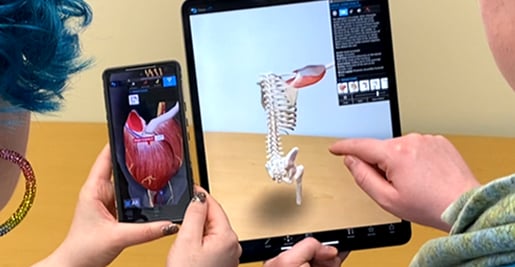How Online Learning Is Thriving in 2023
Posted on 11/13/23 by Maite Suarez-Rivas
The Visible Body team recently joined more than 800 higher education professionals who develop online learning that is effective, enjoyable, and accessible to a diverse group of learners. We attended the Online Learning Consortium’s Accelerate Conference (OLC) in Washington, D.C. The theme this year was “Creating Connections: Uniting Learners through Collaboration and Creativity.”
Here is a roundup of what we learned!

This DNA coiling and supercoiling interactive simulation is available in Visible Body Suite.
What did attendees want?
We spoke with instructional designers, program deans and directors, educational technology and accessibility professionals, and technology specialists who provide instructor support and student success services. Some of the requests we heard are classic to education, while others are more specific to online programs:
- Activities that increase the type of student engagement that leads to success
- Tools that offer the support instructors request to transition their in-person teaching talent into online environments
- Technology that assists with collaboration and discovery that creates so much educational value amongst instructors and students
Online education is a big deal
Hundreds of thousands of students are enrolled in online courses offered at U.S.-based higher education institutions. The National Center for Education Statistics reports that in the Fall of 2021, 24 percent of students pursuing post secondary degrees were enrolled in an all-online program! In a U.S. News & World Report survey, health professions (including online nursing programs) were the degree pursuit of over 30 percent of respondents. Why is this the case?
- Some of the most in demand jobs are in the healthcare field
- Many students are returning to school, have families, jobs, or other commitments, and online learning offers an ideal way to pursue education
How do instructors create successful online assignments?
We heard a lot and pulled the ideas shared into some best practices from educators who have been teaching online courses for years:
Diversify
Students are more engaged when you mix it up! Try reading assignments, videos to watch, projects to complete, and brief assessments.
Keep it short
Online learning is often chosen by students so they achieve learning on their own schedule. Create learning experiences that take 30, 40, or 60 minutes—sometimes 20 minutes! If an activity is a project, break it up into a series of assignments that lead into a larger deliverable.
Break up recorded lectures
In-person lecture has questions and in-depth discussions. Recreate that back and forth online by segmenting what would be a 30- to 40-minute lecture with discussion throughout, into just a few minutes of lecture at a time. Then, use a discussion board to engage on those subtopics.
Pair students for short projects
Have students create a 10 minute presentation on a topic, and then pair them with another student to do a peer review. To complete the peer review, students can use a basic rubric for 3-4 general presentation areas. For each area, the rubric could include questions like these: What is strongest about this area of the presentation? What is one suggestion for improving it?
VB Suite is packed with interactive models, animations, and study tools that keep students engaged!
What's the best way to support instructors transitioning to hybrid or online courses?
Meet them where they are!
Some instructors will jump right into technology—we heard about a philosophy course in which all the students and the instructor were physically in a classroom, each seated and wearing a VR headset. The lecture, smartboard, and discussions all used a virtual classroom and avatars! Students later shared that using avatars actually made them less hesitant to participate in class discussions.
Other instructors are willing to try one new thing each semester, like the instructor who moved all the low-stakes assessments into an LMS. The work they usually did after every quiz to analyze right and wrong answers, and assess what to teach next, was so much easier when moved out of spreadsheets and viewed instantly in the LMS! Before they tried new technology out on the students, the instructor wanted to try one feature of the LMS.
Some instructors are very hesitant. We heard from one instructional designer who recommended helping the most resistant instructors with school requirements—like moving all their course materials into the LMS, then suggesting one piece of interactive technology students might try—like assigning each student an optional extra credit topic. You could have each student make a Flashcard deck using an online tool, then bring the whole deck together for the class.
Students and educators want scalable, accessible technology
Here are questions we were asked again and again at the VB booth:
- Does your software make it easy to switch amongst languages?
- Can students access it anytime/anyplace or are there time, place, or hardware limitations?
- Do you support screen readers?
- Do you integrate with LMS like Canvas, Blackboard, and Moodle?
To grow online programs, educators are looking for students in their community, a little farther afield, and around the world! They are shopping for technology solutions that could be used by students wherever they are located, with the hardware they have available, and with support for accessibility and various languages. They are also looking for ways that a curriculum can reach a broader audience, lead to strong career skills, and help students think as global citizens.
How can instructors leverage technology like AI?
Online educators cannot monitor learning and assessment in person. There is always some new technology coming up that students can use to get around doing the work or to help them do the work.
One approach to this is to embrace that technology. We heard conversations about how students could use artificial intelligence to create a presentation or write a summary, and bypass doing the work themselves, but what about if the new technology was incorporated into the lesson work? What if it helped students understand and use the technology without getting overwhelmed? Or, what if the instructor incorporated technology and set goalposts and parameters?
To embrace the technology, an instructor could have students use AI as part of the assignment. For example, the assignment could have students:
- Read this blog post on the chambers of the heart.
- Ask the AI tool to write a summary.
- Assess what you considered important and what the AI tool considered important.
- Write a brief analysis of how these compared.
In an assignment like this, students are still reading, synthesizing, and analyzing information, and they're also learning how technology can help them learn more. 
Mobile learning with VB Suite.
That's a wrap!
That’s a wrap for OLC Accelerate 2023, but the next OLC conference is right the corner. The Visible Body team already has plans to attend many conferences in 2024, so keep an eye out!
If you want to learn more about Visible Body software and training, ask for an educator’s trial or demonstration!
Be sure to subscribe to the Visible Body Blog for more anatomy awesomeness!
Are you an instructor? We have award-winning 3D products and resources for your anatomy and physiology course! Learn more here.



